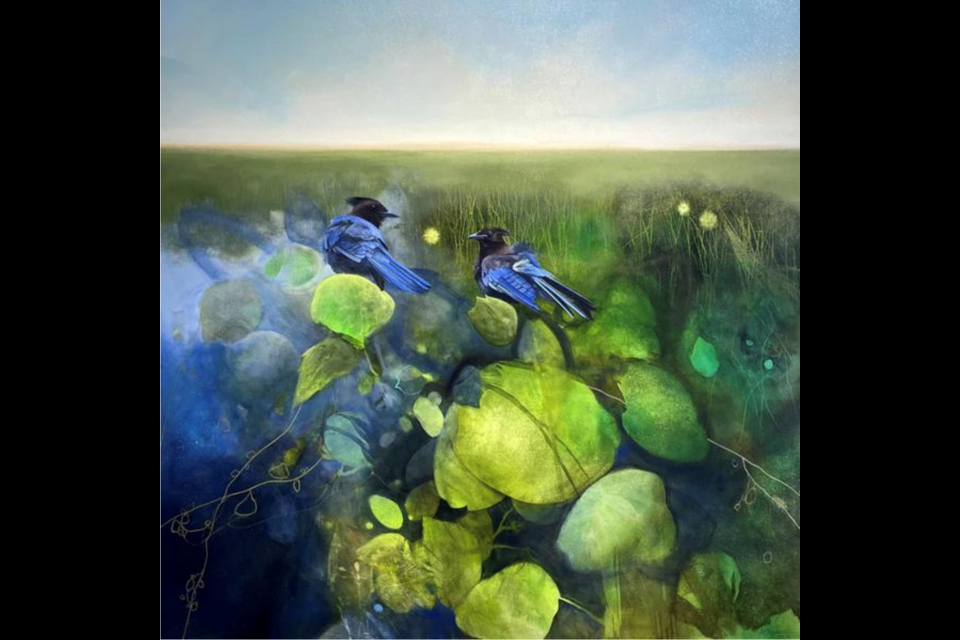BANFF – A pair of summer exhibitions opening at the Whyte Museum of the Canadian Rockies are anything but for the birds.
Opening together, 100 Years: Trail Riders of the Canadian Rockies and For the Birds celebrates the Banff Trail Riders’ centennial anniversary and beauty found in all forms of fowl.
D.L. Cameron, curator and chief of design at the Whyte, said a heightened interest in birding observed throughout the COVID-19 pandemic inspired the latter exhibit.
“It seems to be a lot more prevalent than it ever was before and I think maybe because it was so quiet, we saw more wildlife showing up in spaces where it wasn’t as much before, and everything kind of slowed down,” she said.
“Birds have also been a focus in art forever, and we have so much of that in our collections.”
In addition to select works from the museum, the show features the work of 17 artists of all different mediums, through various disciplines such as ceramics, sculpture, beading, lithographs, photographs, video and, of course, painting.
Video captured by National Geographic photographer Joel Satore is featured in one part of the show in the form of different species of owls laid out on a grid.
The grid is part of Satore’s greater project, the Photo Ark, a series of wildlife portraits and videos made as simply and cleanly as possible to showcase the beauty, grace and intelligence of all creatures, and the fragility of life on Earth.
Money used to rent the video for the use of the show will support ongoing efforts to save endangered species, Cameron said.
“There’s a whole pile of stuff to see,” she said.
“We also have Dan Hudson, who’s from Canmore, and he did this massive piece. The main painting is of Spring Creek in Canmore, with all these bird paintings around it, all of which are birds that he’s seen on his walks through Spring Creek.”
In conjunction with the exhibition, people are also invited to join Peter Poole, one of the initiators of the Banff Community Bird Walk for a self-guided bird walk beginning of Saturday (June 17) near the corner of Sundance Road and Cave and Basin Avenue in Banff.
Later, lyrical painter Jane Appleby will be running an art workshop at the museum, where she will discuss the art in the For the Birds exhibit for inspiration, as well as lead participants in exercises with pens, pencils and Conte on paper to explore personal expression.
To RSVP or register for either event, visit www.whyte.org/events.
Trail Riders
A 100-year milestone is no small accomplishment, nor is encapsulating a century’s worth of history on four small walls.
Such was the challenge Peta Stuart, creative director of displays with the Trail Riders of the Canadian Rockies, volunteered for with 100 Years: Trail Riders of the Canadian Rockies.
“For the Trail Riders this is a wonderful history that they’re trying to convey in a very small space,” said Stuart. “So, we had to get together and brainstorm a little bit to figure out the buckets to communicate what we could with this small space and few walls to tell the story of 100 years – the Trails Riders began in 1923.”
Stuart said the equestrian club asked around their coterie of cowboys to put together the display for the Whyte Museum.
After much discussion, it was determined the display would centre on what else, the trusty steed.
“We asked ourselves ‘what do we have that’s different than any other group that heads out into the mountains?’ The mountain horse, of course,” said Stuart.
“There’s part of the display that focuses on the essential horse. There’s part of the display that focuses on the culture.”
With every ride, the Trail Riders encourage and give a small trophy for the best photograph taken on the trip.
The result is a giant photo archive with thousands of pictures, with photographs taken on older and modern-day cameras.
Other parts of the display explore the culture behind the Trail Riders’ outfitters – the boots, chaps and hats riders wore 100 years ago and what is worn today, and life around the campfire.
“Associated with the campfire is this tradition of music, there’s always a musician with a guitar, and believe it or not, 100 years ago they also hauled in pianos,” said Stuart.
At one point, an organ was also involved, making good use of the club’s pack horses and donkeys.
One of the most fascinating parts of the exhibit, Stuart noted, is that the Trail Riders still exist today.
“Can you believe it? 100 years later, one can still pretty well do that trip in the mountains that happened that long ago. There’s still campfires, there’s still guitar songs, there’s still photographs.”
But, Stuart said, don’t expect to see anyone tickling the ivories on the trail anytime soon. That tradition is one better left to the history books.
For the Birds and 100 Years: Trail Riders of the Canadian Rockies open at the Whyte Museum June 16 and will run until October 15.
The Local Journalism Initiative is funded by the Government of Canada. The position covers Îyârhe (Stoney) Nakoda First Nation and Kananaskis Country.



